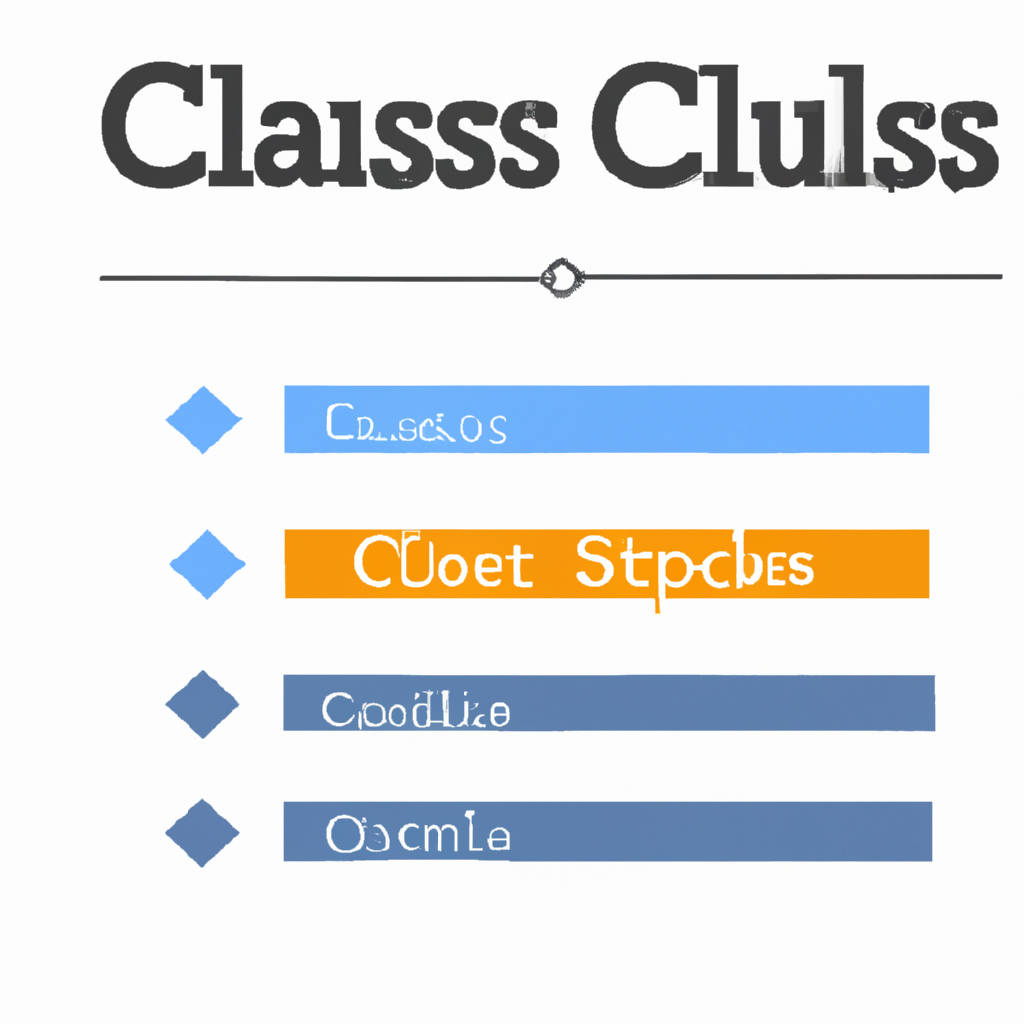CSS classes are an essential aspect of web development, allowing developers to apply styles to elements on a webpage. Understanding how to use CSS classes effectively can greatly enhance the design and functionality of a website. By assigning specific classes to elements, developers can easily target and style them according to their unique properties. This allows for greater flexibility and control over the appearance of a webpage. Additionally, using CSS classes can help streamline the development process by allowing developers to apply consistent styles to multiple elements without having to repeat the same code. Overall, mastering the use of CSS classes is crucial for creating visually appealing and user-friendly websites.

What are CSS Classes?
CSS classes are a fundamental aspect of web development that allows developers to apply styles to specific elements on a webpage. A CSS class is a reusable set of style rules that can be applied to elements in HTML to achieve a consistent look and feel across a website. By assigning a class to an element, developers can easily apply a predefined set of styles without having to repeat the same style rules multiple times. This not only makes the code more efficient and easier to maintain but also ensures a cohesive design throughout the entire website.
CSS classes are defined in a separate CSS file or within the HTML document itself using the class attribute. Developers can create as many classes as needed and apply them to different elements on a webpage. Additionally, CSS classes can be combined with other classes or inline styles to create more complex and customized styles. Overall, CSS classes are a powerful tool that allows developers to apply styles consistently and efficiently, ultimately enhancing the user experience and visual appeal of a website.
How to Define CSS Classes
CSS classes are a fundamental aspect of styling web pages, allowing developers to apply consistent design elements across multiple elements. When defining CSS classes, it is important to follow best practices to ensure efficient and organized code. To define a CSS class, simply create a selector preceded by a period in the stylesheet and then apply the desired styling properties within curly braces. It is common to give classes descriptive names that reflect their purpose, making it easier to understand their function when reviewing the code.
Additionally, classes should be reusable and modular to promote a more efficient workflow and reduce the amount of code duplication. It is also recommended to keep classes specific and focused on a single styling aspect to maintain a clean and organized stylesheet. When applying classes to HTML elements, simply add the class attribute followed by the class name within quotation marks. This allows for easy maintenance and updates to the styling without having to modify individual elements. Overall, defining CSS classes is a key aspect of web development that requires attention to detail and consistency to create a cohesive and visually appealing user experience. By following these guidelines, developers can ensure their code is well-structured and easy to maintain, leading to a more efficient and effective design process.

Applying Classes
Applying classes is a common practice in many industries and educational settings. Classes provide a structured framework for organizing and categorizing information, skills, and resources. By applying classes, individuals and organizations can effectively manage and streamline their processes, leading to increased efficiency and productivity. In an educational context, classes help students to understand complex concepts by breaking them down into manageable units of study. This allows for a more systematic and comprehensive approach to learning.
In the business world, classes are often used to categorize products, services, and customers, making it easier to target specific markets and tailor strategies accordingly. Additionally, classes can help to standardize practices and ensure consistency in operations. Overall, applying classes can have a positive impact on various aspects of our lives, from education to business to personal organization. By utilizing classes effectively, we can better organize information, streamline processes, and improve overall performance.
Applying Classes in HTML
Classes in HTML are a powerful tool for organizing and styling elements on a webpage. By applying classes to different elements, web developers can easily group similar elements together and apply consistent styling across their website. This can help create a more cohesive and visually appealing design. Classes can also be used to target specific elements for CSS styling, making it easier to customize the look and feel of a webpage.
In addition, classes can be reused throughout a website, saving time and effort by avoiding the need to redefine styles for each individual element. By using classes effectively, web developers can streamline their workflow and create a more efficient and professional-looking website. Overall, applying classes in HTML is a fundamental skill for any web developer looking to create well-organized and visually appealing webpages.

Specificity and Cascading
Specificity and cascading are important concepts in various fields such as web design, programming, and communication. Specificity refers to the level of detail and precision in a set of rules or guidelines. The more specific a rule is, the higher its priority in determining the outcome of a situation. This ensures that decisions are made based on the most precise information available, leading to more accurate and effective results.
Cascading, on the other hand, involves the flow of information or instructions from one point to another in a sequential manner. This can be seen in cascading style sheets (CSS) in web design, where the rules are applied in a hierarchical order, with the most specific rules taking precedence over more general ones. This creates a cascading effect where the appearance of a website is determined by a series of rules that build upon each other. By understanding and utilizing specificity and cascading effectively, individuals can create more organized and efficient systems, whether it be in programming languages, design principles, or decision-making processes.
These concepts help to streamline processes, reduce ambiguity, and ensure that the most relevant and accurate information is used to guide actions and outcomes. Ultimately, specificity and cascading enable individuals to make informed choices and achieve desired results in a structured and systematic manner.
Understanding Specificity
Specificity is the concept of being clear and precise in communication or action. When we understand specificity, we are able to convey our thoughts and intentions in a way that leaves no room for misinterpretation. Being specific means providing clear details, examples, and explanations to help others understand exactly what we mean. In everyday interactions, specificity can prevent misunderstandings and conflicts by ensuring that everyone is on the same page.
It can also help us set clear expectations and goals for ourselves and others. In professional settings, specificity is crucial for effective communication and decision-making. For example, when giving instructions or feedback, being specific can help ensure that tasks are completed correctly and efficiently. Additionally, when setting goals or objectives, being specific can help us measure our progress and success more accurately.
‘Overall, understanding specificity can improve our relationships, productivity, and overall effectiveness in various aspects of life. It allows us to communicate more clearly, make better decisions, and achieve our desired outcomes with greater precision. By being specific in our communication and actions, we can avoid confusion, enhance understanding, and ultimately create more positive and successful outcomes.

Recap of CSS Classes
CSS classes are an essential part of web development, allowing developers to apply styles to multiple elements on a webpage with ease. Classes are defined in the CSS stylesheet and can be assigned to HTML elements using the “class” attribute. This allows for consistent styling across a website, as multiple elements can be styled in the same way by simply assigning them the same class. In addition to this, classes can also be used to target specific elements for styling, making it easier to customize the appearance of different parts of a webpage. By using classes effectively, developers can create a cohesive and visually appealing website that is easy to navigate and interact with. Overall, understanding how to use CSS classes is crucial for any web developer looking to create well-designed and functional websites.
Conclusion
In conclusion, it is important to consider the impact of our actions on others and the world around us. We must strive to make choices that promote harmony and well-being for all beings, not just ourselves. It is essential to think critically about the consequences of our decisions and the values that drive them. By reflecting on our beliefs and motivations, we can better understand the underlying reasons for our actions and make more informed choices in the future. In this way, we can work towards creating a more just and compassionate society where everyone’s needs are considered and respected.
Ultimately, our individual actions have the power to shape the world we live in, and it is up to each of us to take responsibility for the impact we have on others. By continuously striving to do better and be better, we can contribute to a more equitable and sustainable future for all. Let us continue to reflect on our values and choices, and make a conscious effort to align them with the principles of kindness, empathy, and respect for all living beings. Together, we can create a world where everyone has the opportunity to thrive and flourish.